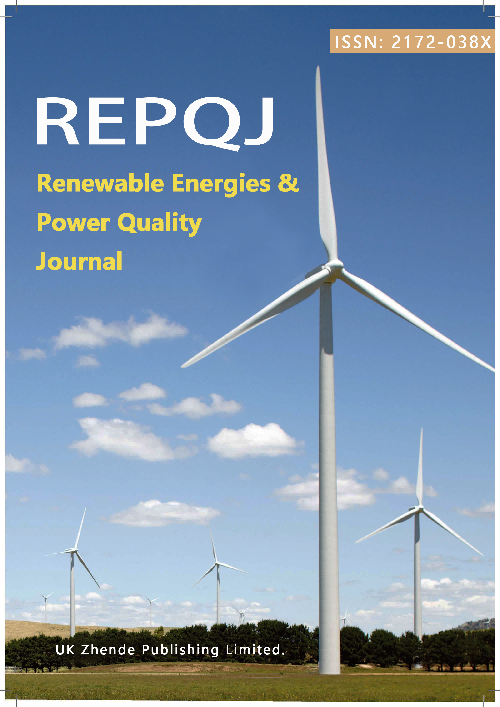An Ultra-Short Term Forecasting Method for Massive Distributed Photovoltaics Considering Spatial-Temporal Correlation
DOI:
https://doi.org/10.52152/4331Keywords:
Photovoltaic power forecasting, Spatial-temporal correlativity, Multivariate variational mode decomposition, Graph convolutional network, Gated cycle unitAbstract
The output of geographically adjacent distributed photovoltaic (PV) units exhibits strong temporal and spatial correlations. PV operators can select representative PV units from many distributed PVs and install real-time data transmission equipment at these locations. By leveraging the correlation of neighboring PV outputs, an efficient forecasting method for large-scale PV can significantly reduce the cost of real-time communication for PV data. In this paper, a framework for an ultra-short-term forecasting method for massive distributed PVs is proposed. Firstly, the initial PV output sequence is decomposed by multivariate variational mode decomposition. Then, based on the decomposed sequence results, the K-medoids algorithm is utilized to categorize the distributed PV units into distinct clusters, with data transmission systems positioned at cluster centers. Finally, a distributed PV ultra-short-term forecasting network is constructed using a dynamic graph convolution and gated cycle unit structure, fully considering the correlation of adjacent distributed PV outputs. The experimental results demonstrate that the proposed ultra-short-term forecasting framework can efficiently plan real-time PV communication equipment and achieve high-precision forecasting of large-scale distributed PVs.
References
https://www.irena.org/Publications/2024/Jul/Renewable-energy-statistics-2024
JG. Kassakian, R. Schmalensee, et al., “The future of the electricity grid: an interdisciplinary MIT study”, Cambridge, MA, Tech.
A. Baviskar, K. Das, M. Koivisto and A. D. Hansen, "Multi-Voltage Level Active Distribution Network With Large Share of Weather-Dependent Generation," in IEEE Transactions on Power Systems, vol. 37, no. 6, pp. 4874-4884, Nov. 2022, doi: 10.1109/TPWRS.2022.3154613.
Z. Fang, Y. Lin, S. Song, et al., “State estimation for situational awareness of active distribution system with photovoltaic power plants,” IEEE Transactions on Smart Grid, vol. 12, no. 1, pp.239–250, 2021.
C. Lyu and S. Eftekharnejad, “Probabilistic Solar Generation Forecasting for Rapidly Changing Weather Conditions” J. IEEE Access, 2024.
C. Huang and M. Yang, “Memory long and short term time series network for ultra-short-term photovoltaic power forecasting” J. Energy, 2023: 127961.
X. Zhu, R. Ju, X. Cheng, et al., “A very short term prediction model for photovoltaic power based on numerical weather prediction and ground-based cloud images” [J]. Automation of Electric Power Systems, 2015, 39(6):4-10.
J. Liu, H, Zang, Cheng L, et al., “A Transformer-based multimodal-learning framework using sky images for ultra-short-term solar irradiance forecasting” J. Applied Energy, 2023, 342: 121160.
J. Yan, L. Hu, Z. Zhen, et al., “Frequency-domain decomposition and deep learning based solar PV power ultra-short-term forecasting model” J. IEEE Transactions on Industry Applications, 2021, 57(4): 3282-3295.
Y. Jiang, L. Zheng and X. Ding, “Ultra-short-term prediction of photovoltaic output based on an LSTM-ARMA combined model driven by EEMD” J. Journal of Renewable and Sustainable Energy, 2021, 13(4).
J. Wang J, Y. Yu, B. Zeng and H. Lu, “Hybrid ultra-short-term PV power forecasting system for deterministic forecasting and uncertainty analysis” J. Energy, 2024, 288: 129898.
H. Xiao, W. Zheng, H. Zhou, et al., “Ultra-short-term photovoltaic power prediction based on improved temporal convolutional network and feature modeling” J. CSEE Journal of Power and Energy Systems, 2024.
F. Wang, X. Lu, S. Mei, et al., “A satellite image data based ultra-short-term solar PV power forecasting method considering cloud information from neighboring plant” J. Energy, 2022, 238: 121946.
H. Zang, D. Chen, J. Liu, et al., “Improving ultra-short-term photovoltaic power forecasting using a novel sky-image-based framework considering spatial-temporal feature interaction” J. Energy, 2024, 293: 130538.
J. Liang and W. Tang, “Ultra-short-term spatiotemporal forecasting of renewable resources: An attention temporal convolutional network-based approach” J. IEEE Transactions on Smart Grid, 2022, 13(5): 3798-3812.
G. Wang, S. Sun, S. Fan, et al., “A spatial–temporal data-driven deep learning framework for enhancing ultra-short-term prediction of distributed photovoltaic power generation” J. International Journal of Electrical Power & Energy Systems, 2024, 160: 110125.
K. Dragomiretskiy and D. Zosso, “Variational mode decomposition” J. IEEE transactions on signal processing, 2013, 62(3): 531-544.
N. Rehman and H. Aftab, “Multivariate variational mode decomposition” J. IEEE Transactions on signal processing, 2019, 67(23): 6039-6052.
H. S. Park and C. H. Jun, “A simple and fast algorithm for K-medoids clustering” J. Expert systems with applications, 2009, 36(2): 3336-3341.
J. Macqueen, “Some methods for classification and analysis of multivariate observations” C. Proceedings of 5-th Berkeley Symposium on Mathematical Statistics and Probability/University of California Press. 1967.
T. N. Kipf and M.Welling, “Semi-supervised classification with graph convolutional networks” J. arXiv preprint arXiv:1609.02907, 2016.
J. Chung, C. Gulcehre, K. Cho and Y. Bengio, “Empirical evaluation of gated recurrent neural networks on sequence modeling”, arXiv:1412.3555, 2014.
Downloads
Published
Issue
Section
License
Copyright (c) 2025 He Yu, Yingchun Wang, Wei Wei, Li Ye, Jun Li, Yalan Wang (Author)

This work is licensed under a Creative Commons Attribution 4.0 International License.











